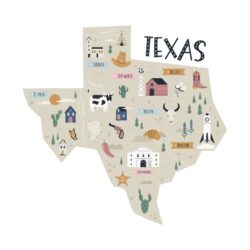
Interesting Details of Texas Cultural and Natural Wonders
- Bat Colony
- State Mammal
- State Dish
- Marfa Lights
- State Dance
- Wildflowers Galore
- Rodeo Capital
- Space Exploration
- Bats as Pest Control
- Big Bend National Park
- Deep Ellum
- State Dinosaur
- Texas Instruments
- Caddo Lake
The Congress Avenue Bridge in Austin isn’t just a bridge; it’s home to the largest urban bat colony in North America. Every summer, thousands of Mexican free-tailed bats take up residence beneath the bridge, creating a breathtaking spectacle as they emerge at dusk, filling the skies with their graceful flight.
In Texas, even the state mammal is unique. The armadillo, with its distinctive armor-like shell and quirky appearance, holds the official title. These little diggers are known for their surprising agility, capable of jumping up to three feet in the air when startled.
Texans have a deep love for chili, and it’s not just any chili—it’s the official state dish. Typically served with beans and topped with cheese and onions, it’s a culinary tradition that’s celebrated throughout the state, often in the form of chili cook-off competitions.
The West Texas town of Marfa is shrouded in mystery thanks to the enigmatic Marfa Lights. These unexplained and ethereal lights that dance across the night sky have captivated the imaginations of locals and visitors alike for generations.
The square dance is the official state dance of Texas, reflecting the state’s rich Western heritage. It’s a lively and energetic dance often performed at social gatherings, festivals, and celebrations.
Texas is known for its breathtaking wildflowers, including vibrant bluebonnets and Indian paintbrushes. These native flowers have been officially designated as the state’s floral emblem, adding splashes of color to the Texan landscape.
Houston proudly wears the title of the world’s largest livestock exhibition and rodeo host. This annual event draws millions of visitors who come to witness thrilling rodeo performances and immerse themselves in Texan culture.
Texas has deep ties to space exploration, with Houston serving as the home of NASA’s mission control center. The first word spoken from the moon was “Houston,” solidifying the state’s role in humanity’s journey beyond our planet.
The bats of Austin do more than create a stunning nightly display; they also serve as invaluable pest control. By feasting on insects during their flights, these bats help keep the local insect population in check.
Located in West Texas, Big Bend National Park is a natural wonder. Its vast desert landscapes, winding Rio Grande River, and rugged canyons make it a haven for outdoor enthusiasts and nature lovers.
The historic neighborhood of Deep Ellum in Dallas has a rich musical legacy. It was a vibrant hub for jazz and blues musicians in the early 20th century, contributing to the city’s diverse cultural heritage.
Texas even has an official state dinosaur, the Paluxysaurus jonesi. Fossils of this sauropod dinosaur were discovered near Glen Rose, adding another layer to the state’s rich paleontological history.
Dallas-based Texas Instruments holds a prominent place in tech history. They developed the first integrated circuit and the first handheld calculator, contributing significantly to the world of technology.
On the Texas-Louisiana border, you’ll find Caddo Lake, home to the largest natural cypress forest. The serene waters, picturesque cypress trees, and unique ecosystems make it a hidden gem in the Texas landscape.
These additional fun facts about Texas showcase more of the state’s unique characteristics, cultural contributions, and natural wonders. Texas truly offers a rich tapestry of history and diversity to explore!
Areas We Serve






